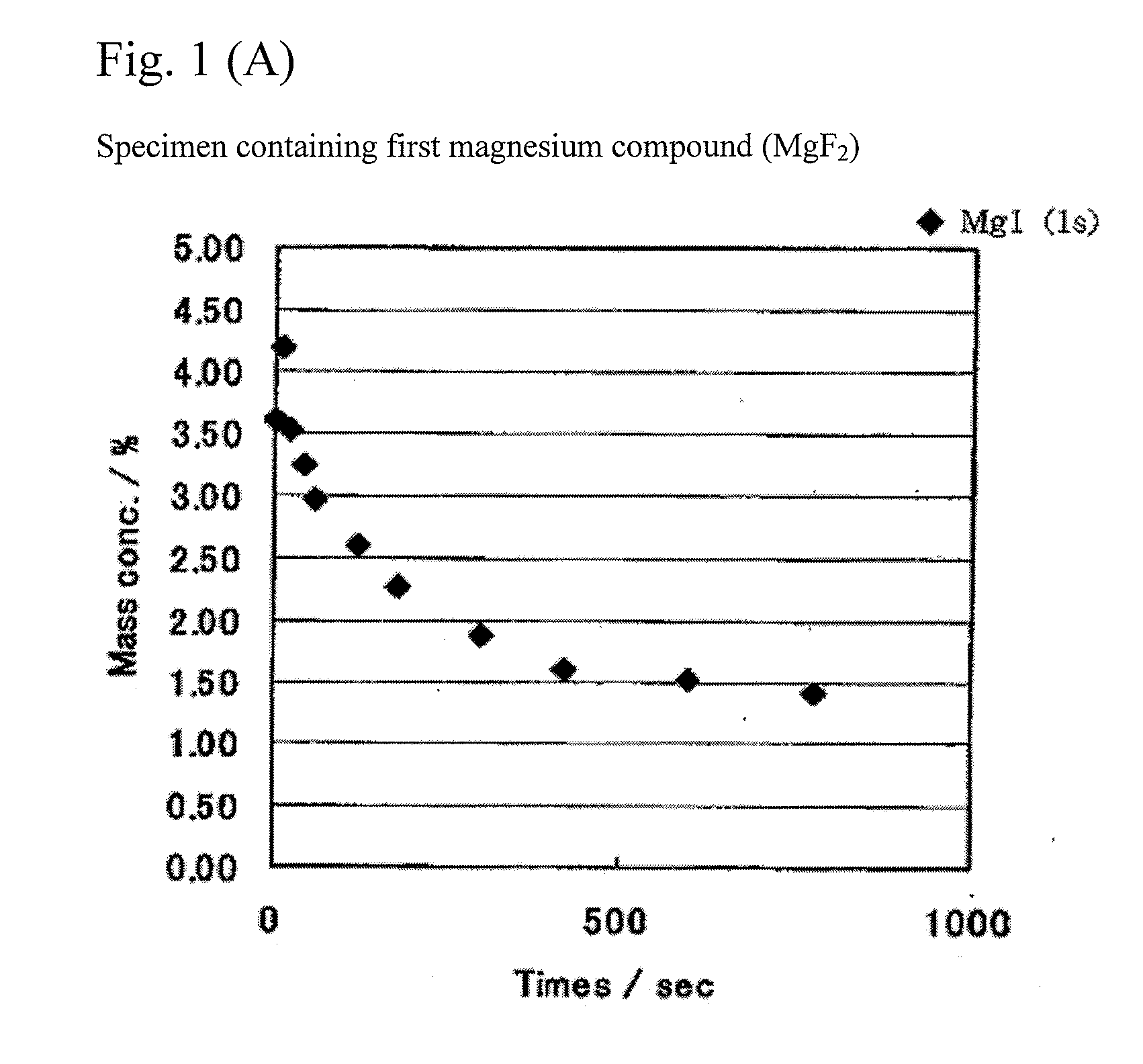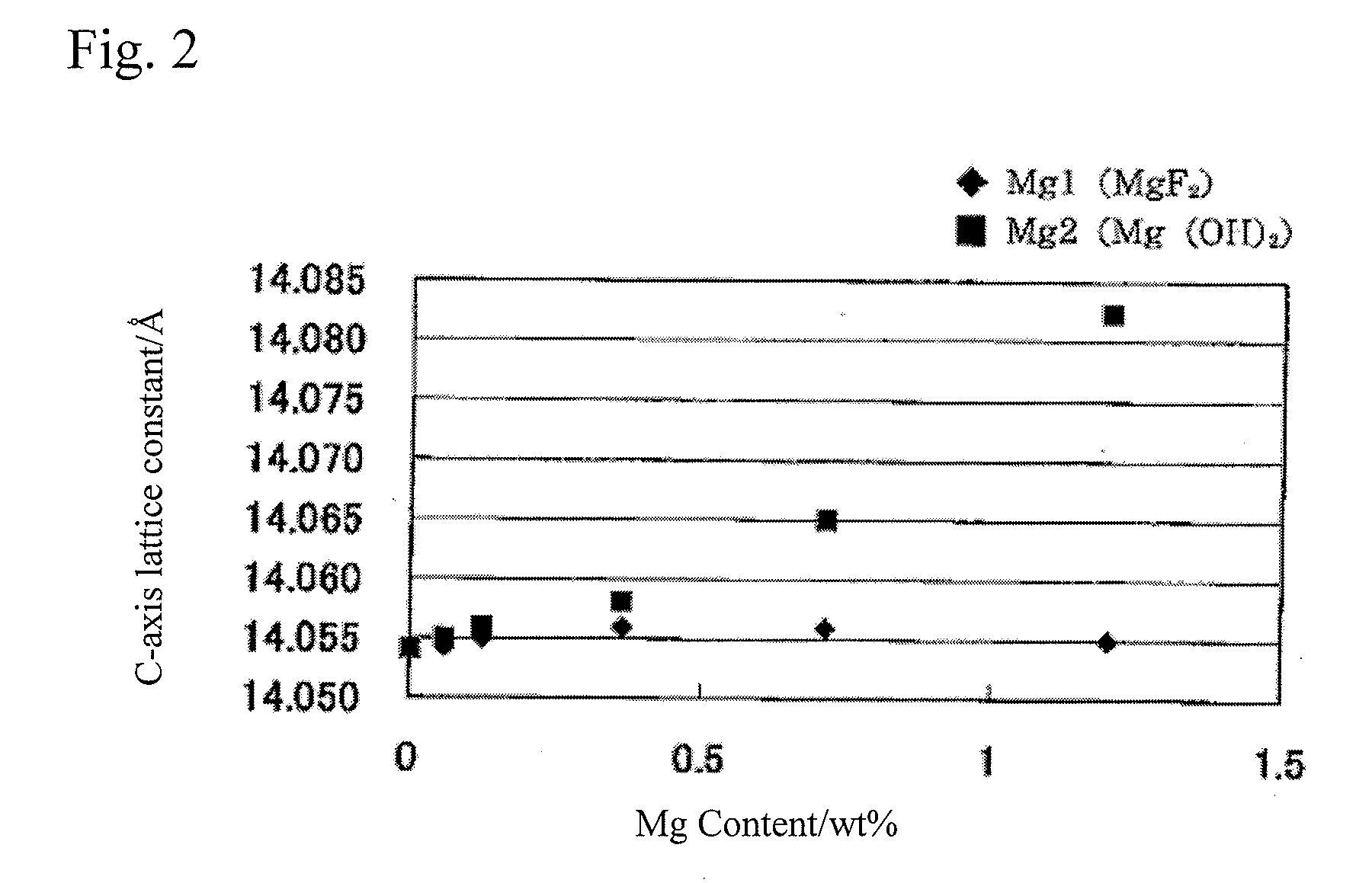Cathode active material for lithium rechargeable battery, manufacturing method thereof and lithium rechargeable battery
a lithium rechargeable battery and active material technology, applied in the direction of aluminium oxide/hydroxide, calcium/strontium/barium oxide/hydroxide, lithium rechargeable battery, etc., can solve the problems of lithium rechargeable battery with cyclic characteristic degradation problem, difficult to achieve satisfactory cyclic characteristic, etc., to improve the safety of lithium rechargeable battery and improve the cyclic characteristic.
- Summary
- Abstract
- Description
- Claims
- Application Information
AI Technical Summary
Benefits of technology
Problems solved by technology
Method used
Image
Examples
embodiments
[0078]The present invention is further explained in detail in the following by using embodiments. The embodiments are merely for exemplification purposes, and the invention is not limited to these embodiments.
[0079]A magnesium compound having solid state properties shown in Table 1 was used. The average particle size was obtained by using a laser particle size distribution measurement method.
TABLE 1SpecimenMagnesium compoundAverage particle size (μm)1-1Mg3(PO4)2•8H2O12.11-2MgF26.01-3MgCl26.02-1MgO5.22-2Mg(OH)228.2(Note)Mg3(PO4)2•8H2O was manufactured by Kishita Chemical Co., Ltd.;MgF2 was manufactured by Stellar Manufacturing Co.;MgCl2 was manufactured by Wako Pure Chemicals Industry;MgO was manufactured by Tateho Chemical Industries Co., Ltd.; andMg(OH)2 was manufactured by Kanto Chemical Co., Inc.
first synthesis example
First Magnesium Compound Added Specimen
[0080]Tricobalt tetroxide (having an average particle size of 2 μm) and lithium carbonate (having an average particle size of 7 μm) were weighed so as to have a molar ratio (Li / Co) of 1.030 between Li and Co. As the first magnesium compound, MgF2 (having an average particle size of 6 μm) was further added so as to have an Mg content of 1.2 weight % in a resulting product. A uniform mixture of these raw materials was obtained by thoroughly performing a dry type mixing. The mixture was put in an alumina pot and sintered for 5 hours at 1050° C. in an air atmosphere. After sintering, the sintered product was collected by putting the pot upside down. The collected product was ground and classified, and a lithium transition metal composite oxide containing Mg atoms was obtained.
[0081]Lithium transition metal composite oxides containing Mg atoms were similarly obtained by adding MgF2 so as to have Mg contents of 0.1 weight %, 0.2 weight %, 0.3 weight ...
second synthesis example
Second Magnesium Compound Added Specimen
[0082]Tricobalt tetroxide (having an average particle size of 2 μm) and lithium carbonate (having an average particle size of 7 μm) were weighed so as to have a molar ratio (Li / Co) of 1.030 between Li and Co. As the second magnesium compound, Mg(OH)2 (having an average particle size of 28.2 μm) was further added so as to have an Mg content of 1.2 weight % in a resulting product. A uniform mixture of these raw materials was obtained by thoroughly performing a dry type mixing. The mixture was put in an alumina pot and sintered for 5 hours at 1050° C. in an air atmosphere. After sintering, the sintered product was collected by putting the pot upside down. The collected product was ground and classified, and a lithium transition metal composite oxide containing Mg atoms was obtained.
[0083]Lithium transition metal composite oxides containing Mg atoms were similarly obtained by adding Mg(OH)2 so as to have Mg contents of 0.1 weight %, 0.2 weight %, ...
PUM
| Property | Measurement | Unit |
|---|---|---|
| particle size | aaaaa | aaaaa |
| particle size | aaaaa | aaaaa |
| particle size | aaaaa | aaaaa |
Abstract
Description
Claims
Application Information
 Login to View More
Login to View More - R&D
- Intellectual Property
- Life Sciences
- Materials
- Tech Scout
- Unparalleled Data Quality
- Higher Quality Content
- 60% Fewer Hallucinations
Browse by: Latest US Patents, China's latest patents, Technical Efficacy Thesaurus, Application Domain, Technology Topic, Popular Technical Reports.
© 2025 PatSnap. All rights reserved.Legal|Privacy policy|Modern Slavery Act Transparency Statement|Sitemap|About US| Contact US: help@patsnap.com



